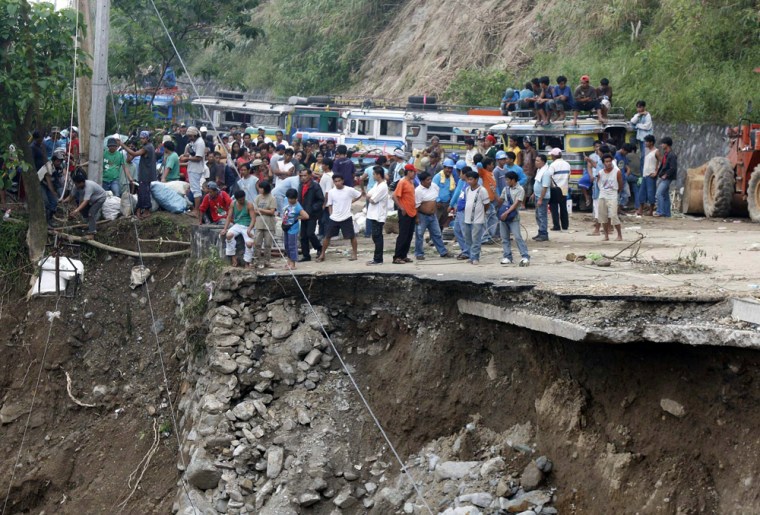U.S. Marine CH-46 helicopters loaded with rice, sardines and drinking water flew Sunday into a stricken Philippine mountain city where supplies are running short after landslides triggered by a storm blocked roads and buried dozens of residents.
Three days after tons of mud and rock cascaded down hillsides in Baguio because of heavy rains, rescuers were still digging for survivors. Meanwhile, panic buying of canned goods emptied several stores in the city, and authorities were forced to ration gasoline.
"There is nearly zero gasoline supply now, and we're running low on food," city police chief Agrifino Javier told The Associated Press.
But as Tropical Depression Parma blew out late Saturday after drenching the country's north for a week, the overwhelmed government, helped by the U.S. military, was able to step up relief efforts.
More than 600 killed
Back-to-back typhoons in the past two weeks have killed more than 600 people in the northern Philippines, posing a severe test to the authorities. Hundreds of thousands are still displaced from their homes, and the damage caused runs into hundreds of millions of dollars.
Baguio lies in a swath of the north where Parma's rains have left at least 276 people dead. Some 53 of them died in Baguio, a summer tourist destination, 130 miles (210 kilometers) north of the capital Manila, known for its cool climate and winding, pine tree-lined roads.
Flooding and mudslides have blocked three key roads to the area, isolating the upland region for three days, said Marine Capt. Jorge Escatell, a U.S. military spokesman.
Police chief Javier said many foreign tourists were among those stranded.
On Sunday, four twin-rotor CH-46 helicopters flew in the supplies to Baguio. President Gloria Macapagal Arroyo also came by helicopter and ordered officials to hasten efforts to reopen the roads. One was reopened Sunday, but only partly, allowing cars but not relief trucks to pass, Philippine disaster-response agency spokesman Lt. Col. Ernesto Torres said.
In nearby Benguet province, police and volunteer gold miners pulled more bodies overnight from houses buried by mudslides late Thursday and early Friday, bringing the province-wide death toll from Parma to 175. At least 20 people remain missing, provincial police chief Loreto Espineli said.
Most of the dead were recovered in a mountainside community called Little Kibungan, where tons of mud and floodwaters buried or swept away houses as people slept.
Marsman Diang said he wept as he frantically dug into the mud Friday for his five nieces and nephews. Four were found dead, wrapped in a bedsheet. One was pulled out barely breathing and did not make it to the hospital alive.
The children's father, Diang's brother, left to work in Japan two months ago to raise money for the kids' education. He heard about their deaths in a phone call from Diang. "He couldn't talk. I heard him weeping with his wife when I called to tell them that their children were gone," Diang said.
Shortage of coffins
Apart from shortage of gasoline, the province has run out of coffins. Volunteers were busy making wooden coffins for six bodies found in Benguet's capital town of La Trinidad, Espineli said.
American and Filipino forces also fanned out in Pangasinan, a rice-producing province to its south, to help provide medical treatment. Nearly all of Pangasinan was inundated by flooding and water released from a major dam.
With large expanses of land still under water, officials said damage to agriculture and infrastructure caused by the two typhoons in the northern Philippines has reached $312 million.
In all, about 700 U.S. Marines and sailors are on land and at sea to help out with the relief effort. Before Parma struck, the 31st Marine Expeditionary Unit, based in Okinawa, Japan, had been helping in the aftermath of Tropical Storm Ketsana which caused the worst flooding in over 40 years in and around Manila on Sept. 26. That storm killed some 337 people in the capital and nearby provinces. More than 241,000 remain in evacuation centers.
Parma made landfall Oct. 3, then roared back and forth across the north for a week, as it reacted to Typhoon Melor that skirted the country from the Pacific Ocean, chief government forecaster Nathaniel Cruz said.
"During the first pass, Parma brought winds, nothing happened and some people thought the worst was over," Cruz said. "Then it returned with heavy rains and many were devastated."
The Philippines has been lashed with 17 typhoons and storms so far this year and about three more are expected, according to Cruz.
